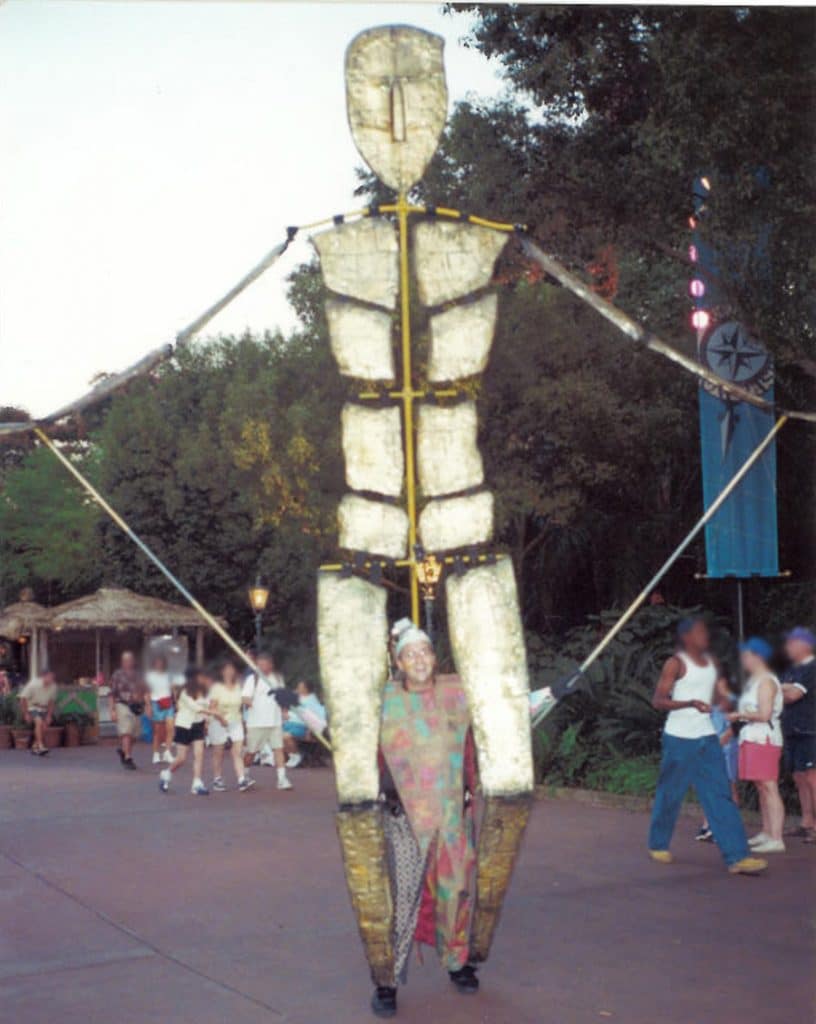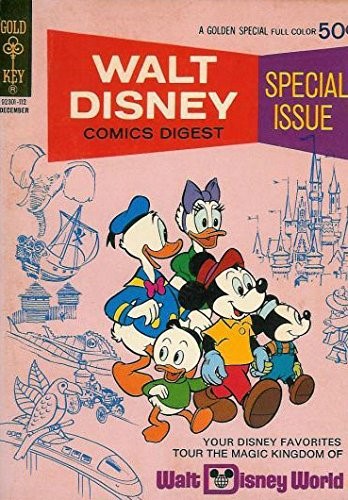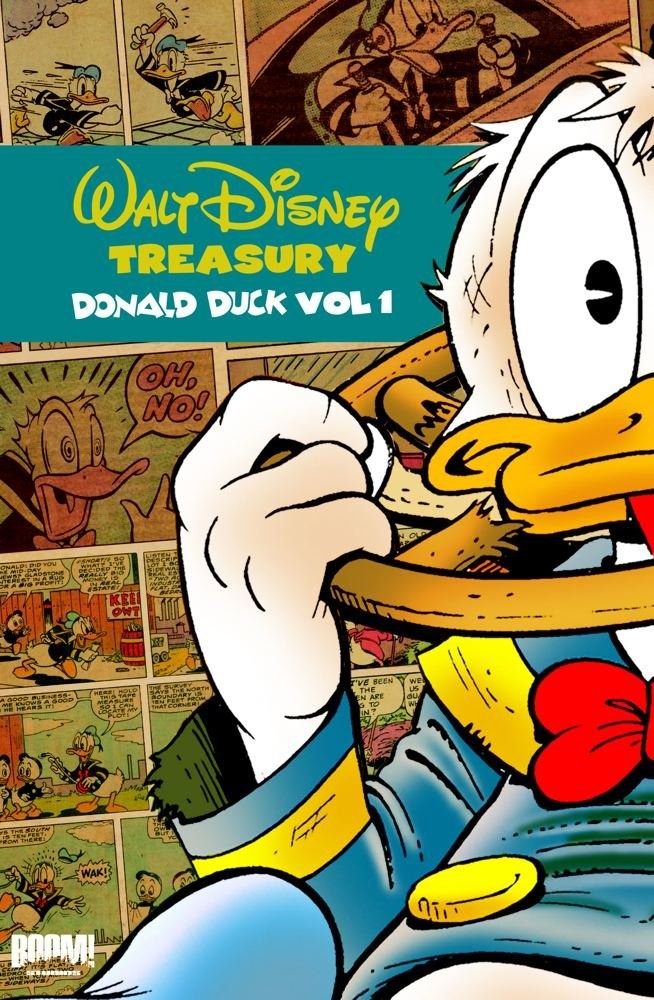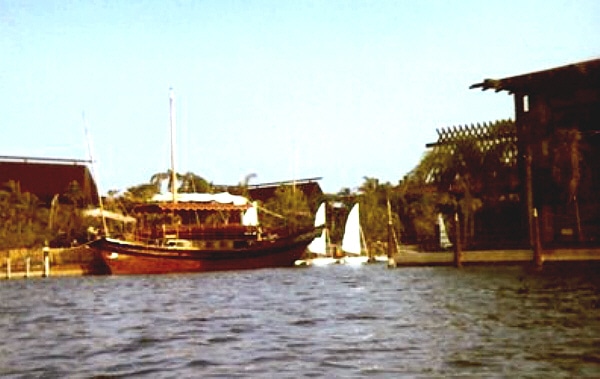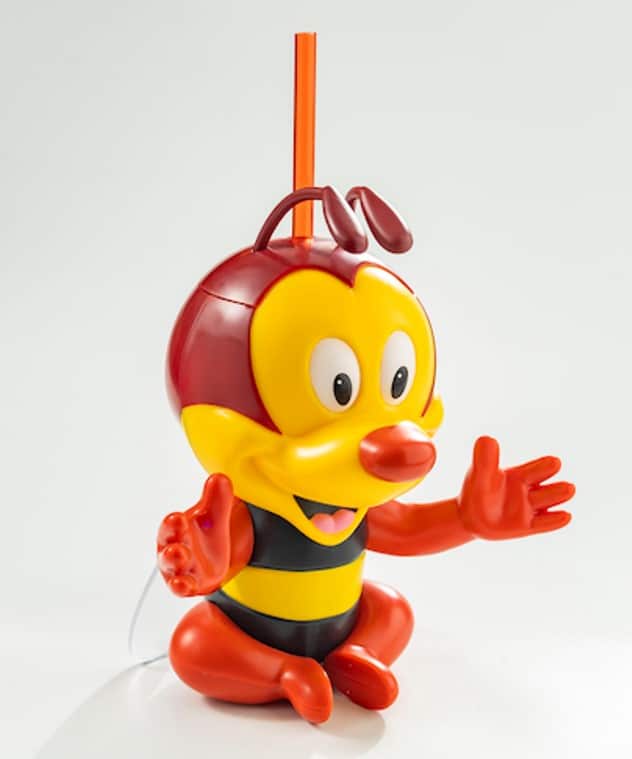Category — A Friday Visit with Jim Korkis
A Friday Visit with Jim Korkis: The Epcot Parades
THE EPCOT PARADES
By Jim Korkis
There was a short-lived World Showcase Parade that started in October 1982 to celebrate the grand opening of Epcot. It included dancers, musicians and costumed characters on the World Showcase Promenade to the music of the Sherman Brothers’ The World Showcase March, but it was performed only a handful of times. This parade was followed by the longer-lived Tapestry of Nations and Tapestry of Dreams parades.
Tapestry of Nations Parade (1999 – 2001)
Tapestry of Nations was selected as the theme to embrace an international audience and to reaffirm the World Showcase commitment.
“A tapestry has many threads and our tapestry symbolically represents the diversity of planet Earth, and our hope for a better world woven with compassion, love, kindness and joy,” explained Show Director Gary Paben. “When you weave all of these elements into it, you have a magnificent image, and that image represents the human spirit.”
The parade’s forty huge puppet characters were designed by Michael Curry, who also designed the puppets for the Broadway stage version of The Lion King. Each puppet weighed between eight and eighteen pounds, and added an additional fifteen to eighteen feet in height to its puppeteer.
The impressionistically-styled puppets were not meant to represent any particular culture, and included Aztec Man, Bird Man, Inverted (or Reverse) Marionette, Angel Girl, Wiggle Girl, Disc Man, Hammered Man and The Sprite.
The puppets were interspersed with fifteen identical rolling percussion units called Millennium Clocks that were 19 feet tall and 16 feet wide, with drummers on each side.
In order to effectively control the time of the parade around the lengthy World Showcase Promenade walkway to roughly twenty minutes, three separate identical units were released simultaneously at different locations along the parade route.
One unit started from the area between the Millennium Village and the UK pavilion; another from between Morocco and Japan and the third from the gate between Germany and the Refreshment Outpost. Sometimes the route would be reversed, and over the years, as Tapestry of Nations changed into Tapestry of Dreams, were reduced to two processions and finally just one.
The parade began with the Sage of Time, who was represented by a stilt walker wearing a white robe with gold trim that had designs of timepieces and alchemy symbols as well as a headpiece resembling a sun with a face.
The music was composed by Gavin Greenaway, who also scored IllumiNations 2000: Reflections of Earth. The parade included the song Celebrate the Future Hand in Hand.
There were actually three versions of Tapestry of Nations, primarily with differences in the audio, like changing the more serious narration of the Sage of Time into a more gentle interpretation, and later incorporating the idea of dreams. Tapestry of Nations served as the theme of the 2000 Super Bowl XXXIV halftime show with the Sage of Time and huge puppets.
Tapestry of Dreams Parade (2001 – 2003)
Because of its popularity, the parade was re-themed into the Tapestry of Dreams Parade and traveled from Mexico to Morocco twice a day.
The Sage of Time was replaced by three Dream Seekers: Elfen (nature, magic, emotion), Cosmos (space, the universe, infinity) and Leonardo Columbus (discovery, invention and genius). The parade concept was re-themed to be a “visible dream” in which ideas, images, and emotions are evoked and the dreams of the guests, especially the children, are collected in the hope that they will spring to life.
The music (with additional contributions from Jonathon Barr) now featured new spoken introductions by the Dream Seekers and the voices of children speaking their dreams in many different languages. The parade also had a tribute to Walt Disney who it proclaimed was “…the greatest and most wonderful dreamer of all!”
Children would write their dreams down on a piece of paper and place them in the butterfly style nets of the Dreamkeepers as they harvested them as they passed by those along the parade route.
* * * * *
Thanks, Jim! And come back next Friday for more from Jim Korkis!
In the meantime, check out his books, including his latest, Disney Never Lands, and about planned but unbuilt concepts, and Secret Stories of Walt Disney World: Things You Never You Never Knew, which reprints much material first written for this site, all published by Theme Park Press.
May 1, 2020 No Comments
A Friday Visit with Jim Korkis: Marc Davis In His Own Words
YOUR PERSONAL DISNEY LIBRARY (28)
By Jim Korkis
- Marc Davis In His Own Words by Peter Docter and Christopher Merritt
Disney related books are getting more and more expensive, with several costing over a hundred dollars each. For those of us on a very limited discretionary budget for such purchases, the question is always whether such a book could possibly be worth the cost even with a discount on Amazon. My personal opinion is that this book is.
Marc Davis In His Own Words is a massive two volume set that totals 750 pages at the large size of 11 x 2.7 x 12.5 inches. Previous books that included Davis focused on his work in animation as one of Disney’s fabled Nine Old Men. For instance, I also have in my library Marc Davis: Walt Disney’s Renaissance Man (2014) that showcases some of his amazing art work on characters ranging from Princess Aurora to Tinker Bell to Maleficient and Cruella De Vil.
What makes this book unique is that other than a brief introductory chapter on the animation done by Davis, it focuses completely on his work in WED/Imagineering for the Disney theme parks worldwide.
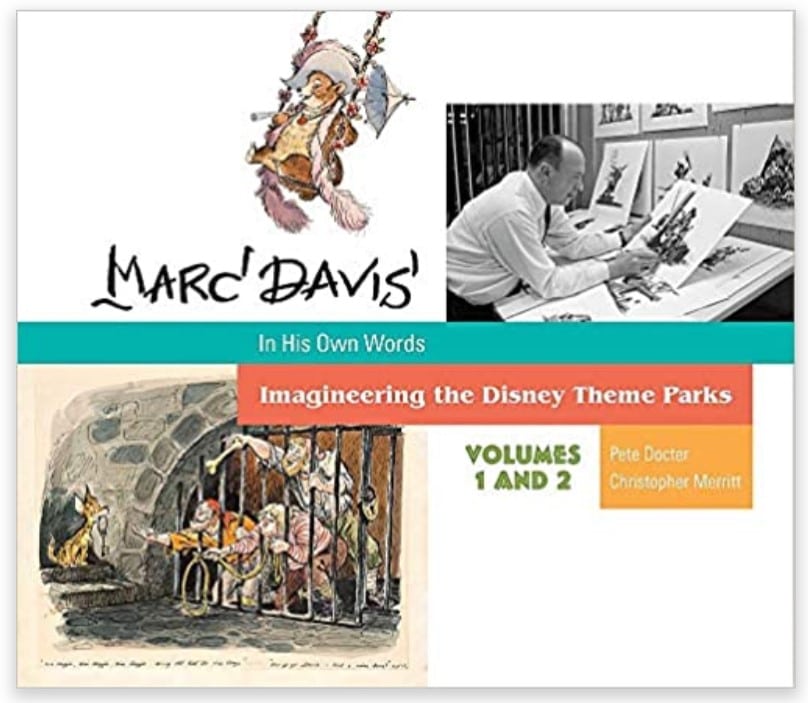
Marc Davis In His Own Words overflows with beautiful artwork done by Davis from all of those attractions and many more including some proposals that never developed like Thunder Mesa and The Enchanted Snow Palace in large, colorful images.
The two authors spent five years researching and designing the book because they didn’t just want to include art that has never before been shared but they wanted the text to be in Davis’ “own words” so they had to search hundreds of interviews done by Davis over the decades. In addition, there are short supplemental quotations from those who worked with Davis to add some insight into the artwork.
The authors are both highly talented and beloved in addition to being internationally recognized as authorities in Disney history. Pete Docter is perhaps best known as a director for Pixar animated features like my favorite, Monsters Inc., as well as winning Oscars for Inside Out and Up along with many, many other awards and nominations.
Christopher Merritt has a background as an art director and production designer for theme parks worldwide and is currently an Imagineer. He is the author of two of the favorite books in my personal library: Knott’s Preserved (2010) and Pacific Ocean Park: The Rise and Fall of Los Angeles’ Space Age Nautical Pleasure Pier (2014).
When Merritt contacted me for permission to use my interviews with Marc Davis, I did not hesitate for even a second. I was not compensated in any way (eg. no free copy of the book) although my name does appear in the acknowledgements along with dozens of others. Just having that small appearance in this magnificent book is pretty gratifying.
My advice is to save your pennies and keep looking for discounts. Just before the Christmas holidays, the book was listed on Amazon for only seventy dollars which is still pricey, but a great value.
* * * * *
Thanks, Jim! As you note, Marc Davis In His Own Words is quite expensive–but if you can afford it, the value is there. The only more expensive book in my Disney Library is The Walt Disney Film Archives. The Animated Movies 1921–1968, which I actually bought twice, giving one as a thank-you gift to Josh for putting up with me…
Come back next Friday for more from Jim Korkis!
In the meantime, check out his books, including his latest, Disney Never Lands, and about planned but unbuilt concepts, and Secret Stories of Walt Disney World: Things You Never You Never Knew, which reprints much material first written for this site, all published by Theme Park Press.
Follow yourfirstvisit.net on Facebook or Twitter or Pinterest!!
April 24, 2020 No Comments
A Friday Visit with Jim Korkis: The Lost Disney-MGM Studios Comic Book Story
Welcome back to Fridays with Jim Korkis! Jim, the dean of Disney historians, writes about Walt Disney World history every Friday on yourfirstvisit.net.
THE STARSTRUCK DUCK
By Jim Korkis
Donald and Mickey: The Magic Kingdom Collection (Walt Disney’s Comics & Stories), published by IDW in 2017, is a collection of seven Disney comic book stories drawn from various sources (including some foreign publications) over the last 60 years that have the Disney cartoon characters exploring Disneyland.
Between 1955 and 1960 Dell produced ten giant-sized twenty-five cent Disneyland comic books containing over ninety pages each of new, original content in each issue. The 10 giant-sized issues were Donald Duck in Disneyland No. 1 (1955), Mickey Mouse in Frontierland No. 1 (1956), Mickey Mouse in Fantasyland No. 1 (1957), Uncle Scrooge Goes to Disneyland No. 1 (1957), Walt Disney’s Christmas in Disneyland No. 1 (1957), Donald and Mickey in Disneyland No. 1 (1958), Walt Disney’s Vacation in Disneyland No. 1 (1958), Disneyland Birthday Party No. 1 (1958), Walt Disney’s Vacation in Disneyland Dell Four Color 1025 (1959, only 36 pages), Walt Disney’s Disneyland U.S.A. (1960).
However, Walt Disney World never received the same attention (unless you count the 1985 Exxon giveaway Mickey Mouse and Goofy Explore the Universe of Energy) except for one issue of Walt Disney Comics Digest, #32.
Walt Disney Comics Digest #32 is the only comic book ever published that has the Disney characters exploring the newly opened Magic Kingdom in Florida, and is 160 pages long.
For that collection of reprinted stories (some of which are actually from Disneyland), there is a new opening splash page drawn by well-known Disney comics artist Tony Strobl (with the realistic backgrounds most likely done by artist Dan Spiegle who drew some of the more realistic live action Disney comic book adaptations).
However, there were also two original stories included in the issue. One featured Scrooge McDuck going back to the Main Street of his youth, drawn by Disney comics artist Pete Alvarado.
Alvarado also drew a nineteen page Frontierland story where Mickey Mouse and Donald Duck go to enjoy the Country Bear Jamboree except three of the bears (Ernest, Big Al and Teddi Barra) have disappeared and must be found for the show to go on. This is the only comic book appearance of these beloved audio-animatronics characters.
I recently discovered there was yet another comic book story, this time about Donald Duck and his nephews trying to get Mickey Mouse’s autograph at the newly opened Disney-MGM Studios that was written and drawn by Don Rosa (to help promote the park) but never published. It was done in 1989.
The story opens with Donald and his nephews in the car driving past the Mickey-eared water tower at the new park. Huey exclaims: “Wow! What a great Florida vacation this is! Disneyworld is the neatest place on earth!” Dewey replies: “I can’t decide which was more fun…the Magic Kingdom or Epcot Center!” Donald interrupts by saying: “Today, we visit Disneyworld’s brand new Third theme park. The Disney-MGM Studios! It just opened!”
Fortunately, Rosa’s complete pencilled script for “The Starstruck Duck” was printed in Walt Disney Treasury: Donald Duck Volume 1 (KaBoom 2011), but I bet few if any WDW fans like myself knew it even existed.
Donald and the nephews visit the Sid Cahuenga One-of-a-Kind shop that also figures into the finale of the story. Donald runs around both onstage and backstage trying to find Mickey. He gets set on fire in Catastrophe Canyon, knocks over the forced perspective scenery on New York Street, tosses out free ice cream bars from the top of Gertie’s head, destroys the ships in the backstage tram tour show (“This isn’t a Duckzilla movie! Grab that guy!”) and more.
Amusingly the stunt show is the traditional cowboy saloon fight done at amusement parks rather than the Indiana Jones show.
For WDW or Don Rosa fans, this is definitely an interesting oddity worth tracking down to add to your collection.
* * * * *
Thanks, Jim! And come back next Friday for more from Jim Korkis!
In the meantime, check out his books, including his latest, Disney Never Lands, and about planned but unbuilt concepts, and Secret Stories of Walt Disney World: Things You Never You Never Knew, which reprints much material first written for this site, all published by Theme Park Press.
Follow yourfirstvisit.net on Facebook or Twitter or Pinterest!!
April 17, 2020 2 Comments
A Friday Visit with Jim Korkis: The Eastern Winds
Welcome back to Fridays with Jim Korkis! Jim, the dean of Disney historians, writes about Walt Disney World history every Friday on yourfirstvisit.net.
THE EASTERN WINDS
By Jim Korkis
When Walt Disney World opened in 1971, it was planned that the principal means of travel from the parking center and main entrance to and from the theme park and hotels would be aboard the Walt Disney World-Alweg Monorail trains. However, during that opening month, only four monorails were operating and could not handle the capacity crowds.
Emergency trams that frequently broke down were immediately put into service to transport guests from the parking lot to the entrance as well as any water craft available, including the keel boats from Frontierland, to ferry guests across the Seven Seas Lagoon to the main entrance.
That included calling into service two specially built temperamental side-wheeler steamboats, “The Southern Seas” and the “Ports-O-Call” that had been built for leisurely Moonlight Cruises through the waterways or special evening charter parties.
When the Magic Kingdom closed for the night, there wasn’t much for adults to do other than the Top of the World musical show on the top floor of the Contemporary. The plan was to have some watercraft for adult evening cruises to offer guests who still wanted to do something on property. Probably the most significant such water vehicle was The Eastern Winds.
The Eastern Winds, a cocktail lounge aboard an authentic 65-foot Chinese Junk, was docked at the Polynesian Resort from 1971 to 1978. It was available for charters, and took a crew of two to operate: a pilot and a deckhand.
The ship included a galley on board for dining as well as a full wet bar. Often during charters, the crew would also include a chef, a server, a bartender as well as a cocktail waitress. The large wheel was located in the stern of the 50,000-pound boat and took 22 turns from lock to lock.
It was built in Hong Kong in 1964, and was later purchased by a Texas oil baron. Football legend Joe Namath owned it at one time as well.
As Sully Sullivan, who helped open WDW in 1971, told me, “There was a real Chinese junk out there in the lagoon and people could rent that boat and take it out for parties. I remember one of the problems was the Disney art directors wanted to paint it, but the wood was teak. You can’t paint teak because then it can’t breathe and the whole thing just rotted. It just stunk to high heavens.
“Pete Crimmings bought that boat down in Miami somewhere, I think. It was somebody’s personal playhouse and there was just a big mattress on the top deck. We had to change all that but it looked great.”
And the end? Ron Cooper and his partner Court Glanadorp were flying in a private plane over Florida and spotted the junk sitting anchored in the Seven Seas Lagoon. Disney had discontinued the cruises and left it in the lagoon as a decoration because it was too much trouble to remove. Cooper made an offer to buy it and within a month, Disney accepted.
However, time and weather had taken its toll on the craft and it was in terrible shape. All the incidentals had been stripped and the varnish was off.
The ship could not be floated anywhere so a trailer had to be positioned under the craft and it was transported along the interstate with much fanfare. When it arrived at its new home, it was launched off the back of the trailer because a crane operator refused to lift it for fear of further damage.
After two years spent refurbishing the boat, it was used for pleasure cruises in St. Thomas in the U.S. Virgin Islands.
* * * * *
Thanks, Jim! Note that the the image is from Tikiman’s material on the early history of Disney’s Polynesian Village Resort.
Come back next Friday for more from Jim Korkis!
In the meantime, check out his books, including his latest, Disney Never Lands, and about planned but unbuilt concepts, and Secret Stories of Walt Disney World: Things You Never You Never Knew, which reprints much material first written for this site, all published by Theme Park Press.
Follow yourfirstvisit.net on Facebook or Twitter or Pinterest!!
April 10, 2020 5 Comments
A Friday Visit with Jim Korkis: Spike the Bee
Welcome back to Fridays with Jim Korkis! Jim, the dean of Disney historians, writes about Walt Disney World history every Friday on yourfirstvisit.net.
SPIKE THE BEE
By Jim Korkis
Spike the Bee is an appealing little character who appeared in a supporting role in several Disney animated shorts released during the 1950s. Since 2018, he has become a sort of unofficial mascot of the Epcot Flower and Garden Festival.
Spike’s Pollen Nation Exploration scavenger hunt was part of this year’s Festival, where guests could purchase a map and search for Spike around the park and then return their completed map for a prize.
Annual Passholders could pick up two complimentary magnets during the 2020 Epcot International Flower & Garden Festival. One of them was the Orange Bird. The other was “Donald Duck with Spike the Bee”. In addition, a cute Spike the Bee Sipper was available at The Honey Bee-stro and contained Honey-Peach Freeze.
The National Honey Board sponsors The Honey Bee-stro where it promotes the story of honey bees, honey and the importance of bees in the ecological system and the importance of protecting those bees.
In the cartoons, Spike has stung multiple times, meaning he’s a bumblebee, as honey bees can only sting once before dying. However, strangely, several of his cartoon adventures show him gathering honey suggesting he is a honey bee.
In recent years, the Spike character has reappeared in episodes of the animated series Mickey Mouse Clubhouse (Goofy’s Bird, Minnie’s Bee Story, Mickey’s Little Parade) and in the Disney Channel Mickey Mouse short cartoons (Bee Inspired, New Shoes). In Bee Inspired, Spike continually disrupts Mickey from posing for Minnie’s painting. However, by the end, he saves Mickey from an angry swarm of bees.
Over the decades, I had the opportunity to interview some of the people involved with creating Spike, who was originally called “Buzz Buzz”.
Jack Hannah was an animator, storyman (with Carl Barks) and director of classic Donald Duck cartoon shorts.
Jack told me that when he became a director on the Donald Duck shorts “one of the first things I did was begin to find some foils for the Duck. There are only so many stories you can come up with for him, but if you have a strong supporting cast, that provides so many more interesting springboards for stories.
“To bring some variety to the Duck shorts, I tried to develop some interesting supporting characters. We used a bee character we called ‘Buzz Buzz’ a lot to antagonize the Duck. Probably the idea was that the bee is a menace with that stinger as a weapon and is much smaller than the Duck so it would be funny having the little guy battling a big bully. You can get a funny sound effect out of a bee. They can cuss you out with that little bee noise.”
That bee-talk was the work of Disney sound effects expert Jimmy MacDonald who always found unusual solutions to difficult problems like blowing through a rubber tube and rubbing on a taut rubber membrane stretched across an old wooden spool to create the bee sound.
Spike was not an aggressive menace. He was actually quite innocent and just did what a bee would instinctively do. However, if he found himself the victim of malicious actions, he had no hesitation to defend himself with his sharp stinger.
If not for the fact that Disney was getting out of the business of making theatrical cartoons in the 1950s, Spike might have ended up with his own series like Pluto, Humphrey the Bear and others.
He appeared in Inferior Decorator (1948), Bubble Bee (1949), Honey Harvester (1949), Slide, Donald, Slide (1949), Bee At the Beach (1950), Bee on Guard (1951) and Let’s Stick Together (1962). He has also made brief cameo appearances in other cartoons over the decades.
* * * * *
Thanks, Jim! And come back next Friday for more from Jim Korkis!
In the meantime, check out his books, including his latest, Disney Never Lands, and about planned but unbuilt concepts, and Secret Stories of Walt Disney World: Things You Never You Never Knew, which reprints much material first written for this site, all published by Theme Park Press.
Follow yourfirstvisit.net on Facebook or Twitter or Pinterest!!
April 3, 2020 No Comments
A Friday Visit with Jim Korkis: Power and Paradise in Walt Disney’s World
YOUR PERSONAL DISNEY LIBRARY (27)
By Jim Korkis
- Power and Paradise in Walt Disney’s World by Cher Krause Knight
In my personal Disney library, I have an entire shelf devoted to books that I call “academic studies” of Disney. In general, they are filled with footnotes and, more often than not, reference other academic books in their bibliographies, rather than any Disney specific books other than a handful of the most familiar common books like Walt Disney: An American Original by Bob Thomas.
This book clearly falls into the “academic studies” category which is why I just recently discovered it even though it was published in 2014. It simply wasn’t mentioned or reviewed in the usual Disney communities, even those devoted to documenting all Disney related books.
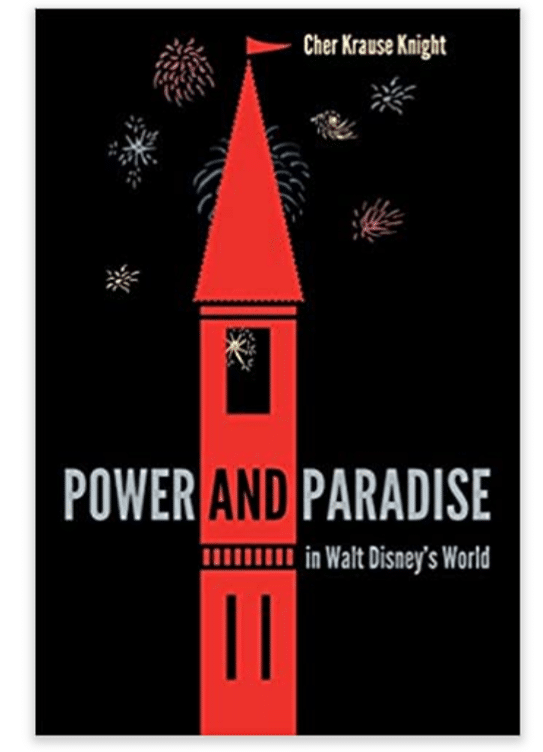
It is amazing how much additional material has been discovered and published about Disney in the years since this book was first released although I doubt whether any of it would change much of anything the author has written.
For instance, I just recently learned that the term “Imagineering” was actually coined by the Alcoa Corporation in 1942 where an advertisement in Time magazine proclaimed, “Imagineering is letting your imagination soar and then engineering it down to earth.” Later in the 1950s, it was used by Union Carbide.
Author Knight is a professor of art history at Emerson College, and has also written the book Public Art: Theory, Practice and Populism. and is also co-editor of A Companion to Public Art and Museums and Public Art? None of the positive reviews for this book are from any Disney related source but all come from scholarly sources.
Knight considers Walt Disney World “a pilgrimage center, a utopia, a fantasy city and a technological and global microcosm” and proceeds to explore those comparisons in different chapters. There is a chapter where the author discusses the comparisons between WDW and Las Vegas where both “seem to transcend space and time, most especially in their retail outposts”.
Knight also spends time covering the “falsifications”, simulations and replicas (to make things more “palpable and potent”) that are used at WDW to create an unreal reality or “hyperreality” and its own moral universe. Basically, not duplicating the real, but fabricating the ideal for its own purposes.
Knight asserts that “Disneyland and the foreign parks are satellite shrines. Disney World is the seat of power. No Disney park fully replicates another and none of the others can rival Disney World in its wide-ranging themes and vast physical terrain. Disney World is where the company’s clout is most visible, accumulated in its most-concentrated form and implicitly consecrated by millions of loyal devotees. Walt spent the last years of his life planning for and fixated on Disney World; it represents not only his vision but also his heart.”
That is only one of several premises in the book that I feel are certainly open to debate. Another concern I have is the following premise.
Knight spends six pages near the end of the book intensively detailing a Keys to the Kingdom tour at the Magic Kingdom and finds it “refreshing” when the guide describes Walt as a “tremendous failure” saved only by his brother’s business savvy since Walt was only a dreamer but Roy was the do-er who made things happen.
I was also concerned that the book gives equal credence to Marc Eliot’s Walt Disney: Hollywood’s Dark Prince as it does Bob Thomas’ Walt Disney: An American Original. Basically, as far as the author is concerned, all the books cited in the text are of equal accuracy.
Actually, despite some of the examples that I have shared, the author often states liking WDW and that it is a “whole dream” that delights the mind and heart. Those readers looking for new information may be disappointed since the familiar tales of Walt’s life story, his being influenced by World Fairs and more are once again trotted out with no original research or new insight.
* * * * *
Thanks, Jim! And come back next Friday for more from Jim Korkis!
In the meantime, check out his books, including his latest, Disney Never Lands, and about planned but unbuilt concepts, and Secret Stories of Walt Disney World: Things You Never You Never Knew, which reprints much material first written for this site, all published by Theme Park Press.
Follow yourfirstvisit.net on Facebook or Twitter or Pinterest!!
March 29, 2020 No Comments

